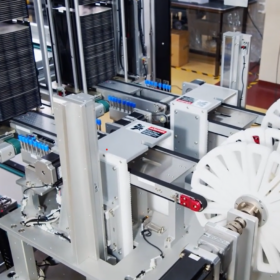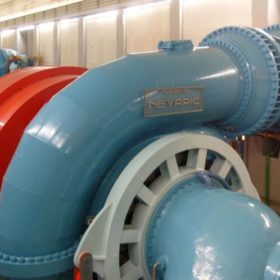Green Hydrogen holds transformative potential for achieving climate neutrality and reshaping the future energy landscape with greater resilience and sustainability. Governments and industries are intensifying their efforts to reduce carbon emissions, and in this pursuit, green hydrogen is proving to be pivotal solution.
Produced exclusively from renewable sources, through zero-emission electrolysis, green hydrogen is a clean, flexible fuel for decarbonisation of the industrial sector.
Pioneering industrial transformation and climate action
Green hydrogen represents more than just a clean fuel option, it is the catalyst poised to transform the energy and industrial sectors fundamentally. As a zero-emission energy carrier, it provides crucial value for segments that have long depended on fossil fuels. Green hydrogen offers a powerful solution to decarbonize hard-to-abate industries like steel, cement and chemicals, simultaneously functioning as a clean feedstock and combustion fuel. This dual role promotes eco-friendly growth, carbon reductions and drives technological advancements.
The horizon of green hydrogen’s impact stretches into transport, where maritime and aviation segments, shaped by strict energy density requirements, are now testing green hydrogen and its derivatives such as green ammonia, methanol acting as gateways to zero-emission operations. Additionally, green hydrogen enables large-scale storage of surplus renewable energy, helping to smooth the fluctuations inherent ensuring grid reliability.
Green Hydrogen in the Indian and global context
India has taken a leadership position with bold ambitions like the National Green Hydrogen Mission (NGHM), aiming the global shift to green energy. The National Green Hydrogen Mission, launched in 2023, aims to produce 5 million tonnes of green hydrogen annually by 2030. Beyond decarbonizing industry, this initiative is expected to save INR 1 lakh crore in annual fossil fuel imports, create over 600,000 new jobs, and position India firmly as a global hub for green hydrogen innovation and export.
This effort is not only about energy transformation, but also about:
1. Cutting down on fossil use: Strong targets and solid policies highlight India’s drive for import substitution and energy strength.
2. Economic growth: New jobs, new tech, and export markets put India as a key player in the world hydrogen value chain.
3. International partnerships: Working with tech leaders like EDL Anlagenbau Gesellschaft mbH (Germany), focusing on green fuels and process innovation, shows India’s plan to speed up industrial decarbonisation by combining global experience and innovation.
On global stage, countries such as Germany and Japan are making significant advancements in integrated hydrogen strategies on global supply chains, international alliances, and sustainable development. International cooperation is essential for scaling technologies, enhancing supply chain resilience and establishing hydrogen as a pillar of the international low-carbon economy.
Economic and technological advantages
Beyond climate benefits, green hydrogen offers distinct logistical and economic advantages:
Green hydrogen is efficient for long-distance transport as it can be carried and stored with less infrastructure compared to electricity thus making it a preferred energy carrier in places where grid lines are not available.
In terms of industrial integration, hydrogen will decarbonize hard industrial processes, replace feedstocks that are high in carbon, and operate the new generation of fuel cells.
Green hydrogen promotes synergy among four previously separate sectors–power, chemical, mobility, and manufacturing systems, thus enabling optimal resource utilization as well as sustainability.
Addressing challenges
Though the prospects are promising, several hurdles need to be addressed.
Production costs: As compared to hydrogen derived from fossil fuels, green hydrogen costs are still higher. Achieving cost parity for green hydrogen hinges on electrolysers technology, expanded production volumes and decline in renewable energy costs.
Infrastructure: Building required infrastructure like transport pipelines and storage facilities is an enormous challenge for public-private coordination to undertake.
Policy and safety standards: Establishing uniform global standards for production, transports and storage is very crucial for mass adoption and international trade.
India faces additional challenges around land for renewables, electrolyser manufacturing and skilled manpower. Therefore, EPC firms need to invest in R&D, innovation and human capital, which addresses these obstacles primarily.
The role of EPC and engineering leadership
The growing green hydrogen industry relies heavily on engineering, procurement, and construction (EPC) expertise, particularly for high-efficiency, scalable systems for low-cost hydrogen production, such as Next-Gen Electrolyser design.
On the other hand, advanced digital tools, artificial intelligence (AI), and the Internet of Things (IoT) are enabling predictive energy management and process optimization—not just within hydrogen production plants, but also across associated chemical facilities. Furthermore, green projects focus on recovering waste heat while integrating renewable energy sources and optimizing plant operation efficiency to execute effective and sustainable project across its lifecycle.
Thus, in conclusion, green hydrogen serves as a foundational pillar to pursue industrial, macro-scale decarbonisation and developing more sustainable energy system for the future. It stands to be a powerful emissions reduction tool while catalysing innovation and providing economic and energy security growth opportunities. As industries and markets transform globally, the vision for engineering, integrated technologies, and relentless teamwork grows stronger progressively.
Authored by: AK Tyagi, Founder, Chairman & Managing Director, Nuberg Engineering Ltd
Nuberg is actively contributing to green hydrogen projects both in India and abroad. Key projects include a 2,000 Nm³/hr hydrogen purification unit for Indian Peroxide Ltd (Gujarat), a 350 Nm³/hr green hydrogen plant for Hygenco Green Energy (Hisar), and a 1,500 Nm³/hr hydrogen purification unit in Uzbekistan. Nuberg’s portfolio also features H₂ balance of stack for BARC and green hydrogen projects for BPCL, Divis Laboratories, and others.
The views and opinions expressed in this article are the author’s own, and do not necessarily reflect those held by pv magazine.
This content is protected by copyright and may not be reused. If you want to cooperate with us and would like to reuse some of our content, please contact: editors@pv-magazine.com.








By submitting this form you agree to pv magazine using your data for the purposes of publishing your comment.
Your personal data will only be disclosed or otherwise transmitted to third parties for the purposes of spam filtering or if this is necessary for technical maintenance of the website. Any other transfer to third parties will not take place unless this is justified on the basis of applicable data protection regulations or if pv magazine is legally obliged to do so.
You may revoke this consent at any time with effect for the future, in which case your personal data will be deleted immediately. Otherwise, your data will be deleted if pv magazine has processed your request or the purpose of data storage is fulfilled.
Further information on data privacy can be found in our Data Protection Policy.